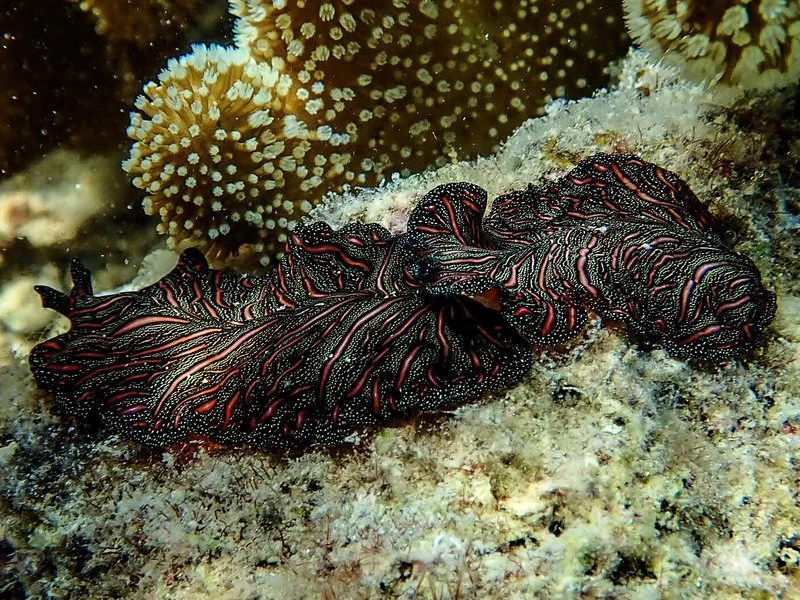Marine flatworms look nothing like the worms we are used to seeing in our gardens. They belong to the phylum Platyhelminthes which are a group of soft bodied invertebrates, which as the name flatworm suggests, are significantly flattened. The platyhelminthes can be divided up into four different groups, cestoda, trematoda and monogenea, all of which are completely parasitic and include things like tape worms and fluke worms. The fourth group is called Turbellaria, most members of this group are non parasitic and this is also the group that marine flatworms belong to. Even though they are closely related to the parasitic groups mentioned, the marine flatworms look nothing like them. They are often beautifully coloured and intricately patterned and their soft, delicate, flattened bodies move gracefully through the water as they swim. These little animals are so flat that their body is only 3 cells thick and the reason for this is that they lack a true body cavity, this means that they cannot have a proper respiratory or circulatory system. The flattened thin body means that oxygen is easily able to diffuse from the water across the skin and into the worm's body.
These invertebrates can be found all over the world but are more common and brightly coloured in warm tropical regions. They live on and around the coral reefs moving around with microscopic hair like structures called cilia, located on their underside. They also have the ability to move through the water column and swim. They do this by moving their bodies in undulating wave motions similar to the movements in Spanish flamenco dancing.
A lot of their time on the coral reefs they call home these guys are looking for food. Some species are predatory and will feed on a variety of other organisms including sponges, molluscs, bryozoans and ascidians (sea squirts) while others are vegetarian and will feed only on algae. They do not have eyes so they are unable to see images in the way that we are, the way they detect prey is with chemoreceptors which are specialised cells with detect different chemicals in the water. Once they have located their prey there are a couple of different methods used to eat depending on the species. Some flatworms will use their soft bodies to move the prey animal to the underside of their body where the mouth is located while others will completely disgorge their “gut” out through their mouth and envelop the prey. Their mouth is also the only opening to their primitive gut, this gut is more like a network of tubes which branch through the body like the roots of a tree.
In return flatworms do not have much to fear from other predators, their appearance is their best defence against being eaten. As is the general rule in the animal kingdom bright colours is. a massive advertisement of toxicity and a warning for would be predators to steer clear. Some flatworms have adopted this policy and display a beautiful array of bright colours and patterns to make themselves appear toxic. Some have even gone the extra mile and will mimic the colouring of poisonous nudibranchs to trick predators. Other species of flatworm have gone in the opposite direction and have a much more muted colouring so that they are able to camouflage on the reef and completely avoid the gaze of hungry eyes.
Just like the nudibranchs they are trying to mimic, flatworms are simultaneous hermaphrodites. This means that they have both male and female sex organs. When they mate flatworms perform a kind of “dance” which is called penis fencing essentially they are fighting for the position of the male. The winner of this fight will then stab or dart the other individual anywhere on the body and pass sperm into them which will make its way to the eggs and fertilise them internally. These eggs are then laid in a jelly like blob and after about 20 days the eggs hatch.
Another way that new flatworms can be produced is through a process called regeneration. If the animal becomes distressed or is damaged by a predator and is broken apart it doesn’t mean the end for that little guy. The pieces will each form new individuals which are clones of the original. Some species will even reproduce normally in this way, this is called fragmentation. The parent will split off part of its body intentionally to form a clone.
Spotting these guys on a snorkel is definitely a highlight. The warm tropical waters and fringing reefs of the Whitsundays are home to many different species of flatworm all waiting to be spotted and admired.

